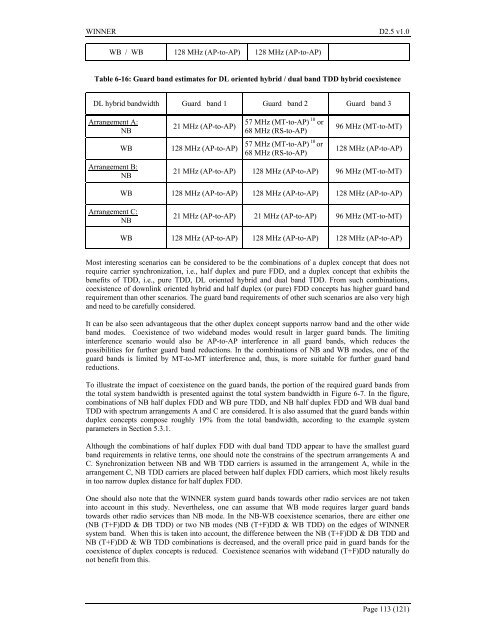IST-2003-507581 WINNER D2.5 v1.0 Duplex ... - Celtic-Plus
IST-2003-507581 WINNER D2.5 v1.0 Duplex ... - Celtic-Plus
IST-2003-507581 WINNER D2.5 v1.0 Duplex ... - Celtic-Plus
- No tags were found...
You also want an ePaper? Increase the reach of your titles
YUMPU automatically turns print PDFs into web optimized ePapers that Google loves.
<strong>WINNER</strong> <strong>D2.5</strong> <strong>v1.0</strong>WB / WB 128 MHz (AP-to-AP) 128 MHz (AP-to-AP)Table 6-16: Guard band estimates for DL oriented hybrid / dual band TDD hybrid coexistenceDL hybrid bandwidth Guard band 1 Guard band 2 Guard band 3Arrangement A:NBWBArrangement B:NB21 MHz (AP-to-AP)128 MHz (AP-to-AP)57 MHz (MT-to-AP) 10 or68 MHz (RS-to-AP)57 MHz (MT-to-AP) 10 or68 MHz (RS-to-AP)96 MHz (MT-to-MT)128 MHz (AP-to-AP)21 MHz (AP-to-AP) 128 MHz (AP-to-AP) 96 MHz (MT-to-MT)WB 128 MHz (AP-to-AP) 128 MHz (AP-to-AP) 128 MHz (AP-to-AP)Arrangement C:NB21 MHz (AP-to-AP) 21 MHz (AP-to-AP) 96 MHz (MT-to-MT)WB 128 MHz (AP-to-AP) 128 MHz (AP-to-AP) 128 MHz (AP-to-AP)Most interesting scenarios can be considered to be the combinations of a duplex concept that does notrequire carrier synchronization, i.e., half duplex and pure FDD, and a duplex concept that exhibits thebenefits of TDD, i.e., pure TDD, DL oriented hybrid and dual band TDD. From such combinations,coexistence of downlink oriented hybrid and half duplex (or pure) FDD concepts has higher guard bandrequirement than other scenarios. The guard band requirements of other such scenarios are also very highand need to be carefully considered.It can be also seen advantageous that the other duplex concept supports narrow band and the other wideband modes. Coexistence of two wideband modes would result in larger guard bands. The limitinginterference scenario would also be AP-to-AP interference in all guard bands, which reduces thepossibilities for further guard band reductions. In the combinations of NB and WB modes, one of theguard bands is limited by MT-to-MT interference and, thus, is more suitable for further guard bandreductions.To illustrate the impact of coexistence on the guard bands, the portion of the required guard bands fromthe total system bandwidth is presented against the total system bandwidth in Figure 6-7. In the figure,combinations of NB half duplex FDD and WB pure TDD, and NB half duplex FDD and WB dual bandTDD with spectrum arrangements A and C are considered. It is also assumed that the guard bands withinduplex concepts compose roughly 19% from the total bandwidth, according to the example systemparameters in Section 5.3.1.Although the combinations of half duplex FDD with dual band TDD appear to have the smallest guardband requirements in relative terms, one should note the constrains of the spectrum arrangements A andC. Synchronization between NB and WB TDD carriers is assumed in the arrangement A, while in thearrangement C, NB TDD carriers are placed between half duplex FDD carriers, which most likely resultsin too narrow duplex distance for half duplex FDD.One should also note that the <strong>WINNER</strong> system guard bands towards other radio services are not takeninto account in this study. Nevertheless, one can assume that WB mode requires larger guard bandstowards other radio services than NB mode. In the NB-WB coexistence scenarios, there are either one(NB (T+F)DD & DB TDD) or two NB modes (NB (T+F)DD & WB TDD) on the edges of <strong>WINNER</strong>system band. When this is taken into account, the difference between the NB (T+F)DD & DB TDD andNB (T+F)DD & WB TDD combinations is decreased, and the overall price paid in guard bands for thecoexistence of duplex concepts is reduced. Coexistence scenarios with wideband (T+F)DD naturally donot benefit from this.Page 113 (121)
















